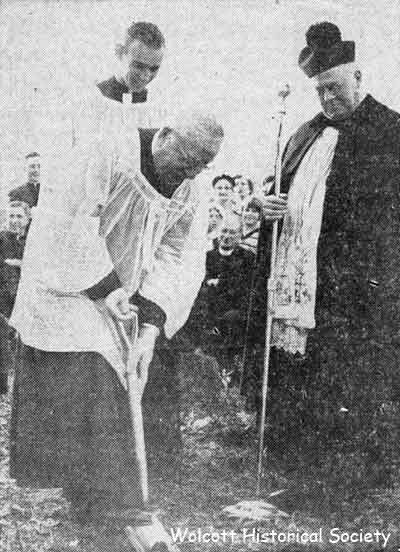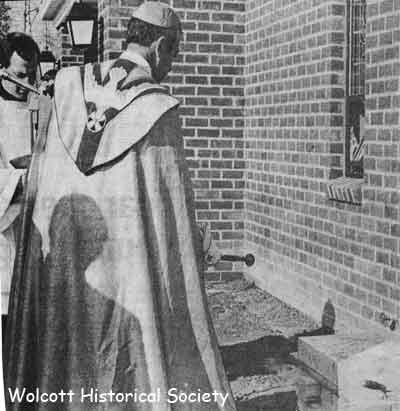|
|
||||||||||||
 |
 |
|
Wolcott Historical Society News - March 2010 By Florence Goodman Throughout history men have traveled far and wide to worship in the church of their choice. In this month's article I will discuss the introduction of the Roman Catholic Church into our town. As with the old and new Woodtick Chapel, the first Catholic Church would be located in the Woodtick area. The dedication of St. Pius X Roman Catholic Church took place in the fall of 1957.
The 1940 census showed the population of Wolcott at 1,765 residents, but with the end of the War, many people left the cities to return to rural areas. Thus by the 1950 census, our town's population had grown to 3,553. Many of those city dwellers that moved into our region were Catholic, who had to travel back to Waterbury or Bristol each Sunday to attend Mass.
Traveling to Waterbury and Bristol was extremely hard during the long winter months; thus a small group of Catholics from the lake area came together hoping to raise funds to erect a chapel. These early meetings along with the establishment of the Knights of Columbus in the town helped to make the Hartford Diocese realize that the time was right for a Catholic Church to be built in Wolcott.
In the spring of 1955, plans were set into motion to find a site for this new church. Waterbury pastors, Father Michael Keating, of Ss. Peter and Paul and Monsignor Edward Shea, of Sacred Heart were consulted to find a likely site since their parishes would be cut to form the new parish in Wolcott. Most of the land for the new church was purchased from the Scovill Manufacturing Company of Waterbury, but a small section of land that was still needed was owned by the State of Connecticut as part of the old Woodtick Road. The purchase of this small section of land was slow in coming and was slowed even more with the flood in August of 1955, but finally by fall of that year, negotiations were completed.
Reverend Raymond P. Shea, assistant pastor of St. Patrick's Church in Hartford was selected as the first pastor of the new church. By December of that year, the church name was decided; it would be called St. Pius X in honor of the newly canonized St. Pius X, who had served the Church as Pope from 1903 to 1914. This was the first church in the Archdiocese named for him.
The residents of Wolcott, regardless of their religion, welcomed the news of a new parish in their town. First Selectman Robert A. Wakelee stated, "ÉIt is most gratifying to see the moral and spiritual growth of our community keeping pace with the material and economic expansion. It is with utmost sincerity that we welcome Father Shea and the new church of St. Pius X to the Wolcott Community."
The Rev. William E. Stone, pastor of the Wolcott Congregational Church stated, "Our Church is glad indeed to see our Roman Catholic neighbors with a church of their own in our town."
The first parish Mass took place on January 8, 1956, in the auditorium of Frisbie School. The auditorium was overflowing by the time the 8 A.M. Mass was to begin and the same was true for the second Mass at 10 A.M. It was estimated that over 700 people attended each Mass that day.
Masses were held weekly in Frisbie School auditorium during the construction of the new church. Originally the parish was to include all Catholic residents of the town, but then the Archbishop decided that those residents in the northern section of town would be closer to Bristol, so they would still attend Mass in Bristol.
It was necessary for the pastor to find a place for the rectory close to the new church and after searching the area, the home of Armand and Loretta Lecomte on Woodtick Road was purchased on January 13, 1956. It was ideal because it had a basement room with a private entrance from the outside, which could be made into a chapel. The parishioners helped with donations of labor and religious articles necessary to turn this room into a beautiful chapel and shrine to St. Pius X. The first Mass was said in this chapel/shrine on February 10, 1956.
Next came the planning and construction of the new church. It was decided to build a church hall at the same time that would serve as a meeting place for various church functions. Since this was an entirely new parish, it had to begin "from scratch" to raise funds through pledges from parishioners over a three-year period. The response to the drive was phenomenal and in the initial eight-week period a sum of $220,000 was pledged; this exceeded the fundraising campaign goal.
In May of 1956, Father Charles Cobb was chosen as assistant pastor for the church. He sang his first Mass on May 13, 1956. By summer of that year a construction company had been chosen for the building of the church and on October 21, 1956, the groundbreaking ceremony was held; construction began the very next day. The building developed brick-by-brick and finally on November 24, 1957, the dedication of the new St. Pius X Church was held. About two years later, they were able to build their new rectory.
The St. Pius X community continued to thrive and with each passing day, various organizations within the church developed. These church organizations consisted of the Knights of Columbus (established as early as 1955), the Catholic Daughters, the Ladies Guild, Sunday School, the CYO (Catholic Youth Organization), St. Mary's Hospital Auxiliary, the Cana Conference, the Retreat League, the Boy Scouts, the Choir, and the Holy Name Society. Each of these organizations was an integral part of this new church community and each helped to support the church though fundraising efforts.
There were several activities that will forever be etched in my mind: the yearly Minstrel Shows that were produced by the CYO, Sunday bowling at Perillo's in Waterbury, again a CYO activity, but especially the Church Carnivals that were held yearly in the parking lot behind the church. As I think back about those carnivals, the only thing that I can compare it to would be the Lion's Fairs today. People came from far and wide to enjoy all the festivities and the homemade food, and the fried dough was GREAT!! The Parish of St. Pius X Roman Catholic Church continued to thrive through the 1960s.
The population of Wolcott continued to increase and by the 1970 census, the town's population had reached 12,495. The same held true for the population of the Catholic Church in town and by July of 1971, Archbishop John F. Whealon announced that a new mission of St. Pius X Parish would be established in Wolcott and Reverend Gerald C. Mullins would be assigned to head the mission. The purpose of this second church was to serve the residents in the northeast section of town. It would also mean that some of the parishioners from St. Pius X would leave that church and become part of the new mission church.
On the last weekend of July, the mission's first Mass was held at Alcott School in the cafeteria; Sunday School was also held at the school. Daily Mass, meetings and social gatherings were held at the Knight's of Columbus Hall on Spindle Hill Road. By January of 1972, the parishioners had decided on a name; it would be called the St. Maria Goretti Mission.
In October of the same year, a house at 7 Beecher Road was purchased to serve as the rectory. The mission was legally denoted a parish and Father Mullins officially became its first pastor on September 8, 1973. And thus, the fundraising began; activities such as carnivals, fairs, cake sales and car raffles were successfully held to help support the new mission.
The parishioners along with Father Mullins worked hard to make this second Catholic church a reality. In March of 1974, approximately 10 acres of land on Woodtick Road was purchased from the New Britain Water Department and by March of 1975, final plans were approved to build a brick colonial church that would seat about 360 people with an attached 3,600 square foot social hall. The groundbreaking ceremony for the new mission took place on May 6, 1975, with about one hundred parishioners in attendance.
On May 3, 1977, parishioners of St. Maria Goretti Mission were shocked to learn that Father Mullins had suffered a fatal heart attack at the age of 55. This sadness was bittersweet because the church was dedicated several months later on November 9, 1977; the church hall was named in Father Mullin's memory. All that Father Mullins had worked so hard for had come to fruition and is still evident today. Reverend Harold Heinrich was appointed Administrator of the Parish in 1978 to replace Father Mullins. He served the Mission well until 1990 when he was transferred to a parish in New Britain. During Father Heinrich's tenure the church rectory was built.
St. Maria Goretti Roman Catholic Church continues to grow under the supervision of Father William Sokolowski. Presently they are building an addition to the church hall to accommodate classrooms for religious instruction so they will no longer need Alcott School for this purpose. The Catholic churches have made significant contributions to the growth and development of our town.
(Information for this article was taken from a booklet, The Seed is Sown published by St. Pius Church and The History of St. Maria Goretti Mission published by St. Maria Goretti Church)
Our Schoolhouse Museum is open by appointment only during the winter months. Anyone interested in visiting the Museum, please call Loretta Leonard at 203-879-4310 or Flo Goodman 203-879-9818.
Groundbreaking Ceremony, October 21, 1956, Rev. Michael Keating, pastor of SS. Peter and Paul Church, Waterbury, taking up a spadeful of earth at site of the proposed St. Pius X Church. Father Charles Cobb is behind him and Father Raymond Shea is to his right.
Dedication of St. Maria Goretti, November 9, 1977, The Most Rev. John Whealon, Archbishop of Hartford, dedicating the new building of St. Maria Goretti Church in Wolcott.
To view past installments of the Wolcott Historical Society News, click here.
|
|
|
[Home]
[News]
[Purpose]
[Calendar]
[Museum]
[Membership]
[History]
[Contacts]
[Links]
All material at Wolcott Historical Society Web sites Copyright © 2000-2010 Wolcott Historical Society |

